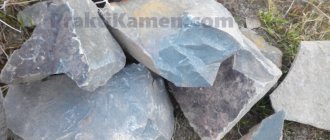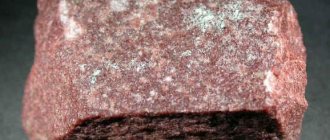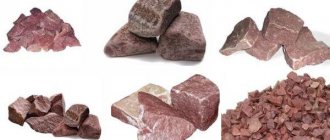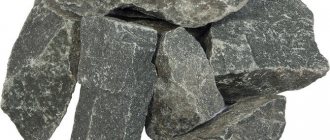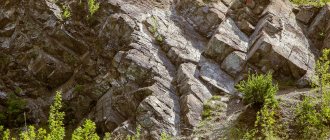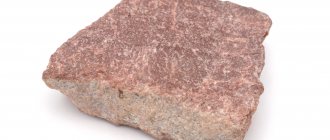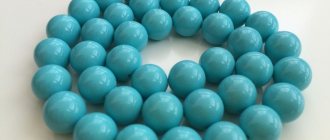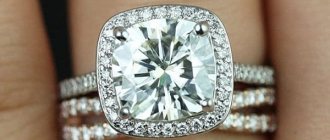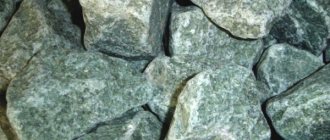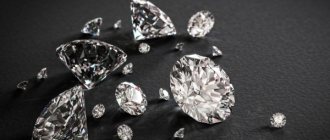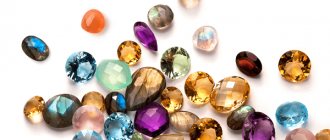Field
Gabbro-diabase - gabbrodolerite , volcanic rock.
Today, gabbro-diabase is mined in three regions: Ukraine, Australia and Karelia, but it is possible that gabbro-diabase mining may be initiated in other countries or regions of Russia in the future.
Karelian gabbro-diabase is mined in Karelia, the largest developed deposit is located near the village of Drugaya Reka, so most often we encounter Drugoretsk gabbro-diabase, but in Karelia there are other deposits of gabbro-diabase, which are being mined or planned in the near future . The Karelian Granite Company is the owner of a deposit of absolutely black gabbro in the Loukhsky district, not far from the village of Kestenga. The gabbro here has an absolutely black color, an analogue of Chinese black granite; often the blocks of this deposit are called “Rombak” or “Karelia black”.
The specificity of the fracture system of the Drugoretskoye deposit is such that the most optimal and effective method for extracting gabbro-diabase blocks here is the drill-and-blast method. At the field near Shoksha, this method is also used, but in the northern regions of Karelia, production is carried out by wire sawing.
Types of ritual graphics for decorating a gabbro granite monument
We offer to buy a monument made of Karelian gabbro and decorate it in our art workshop using various engraving methods.
We carry out manual, laser (standard) and milling engraving:
- Shoulder-length, full-length portraits and photographs are made by engraving, pasting in photoceramics, in the form of a photo on glass or a bas-relief.
- Inscriptions of full name, dates of life, epitaphs are done in any font; in addition, you can order crosses, vignettes, flowers, candles.
- We apply images to the monument on the front or back side, on a cabinet or on a tombstone. Images can be made in color using Italian durable paint (5 year guarantee), and texts can be covered with gold leaf.
Characteristics of Gabbro-diabase
A stone of igneous origin, characterized by a rich grain structure and subtle shades. The geological age of the rock is more than 2.5 billion years, while the closest analogues of gabbro-diabase are less than 1.5 billion years old. Gabbro-diabase differs from granite in that it was formed from magma poor in silica, while granite, on the contrary, is formed from magma rich in silica. Silica is a characteristic of the presence of quartz in gabbro-diabase, therefore granite contains quartz, but gabbro-diabase does not. Granite consists of: quartz, feldspar and mica. And gabbro-diabase is mainly made of plagioclase and pyroxene.
What is the breed
As you can already judge from the name, this stone is a “transitional” link between diabase and gabbro. According to its characteristics, the rock is close to basalt and granite. It is a gabbro-diabase stone of a dark gray or greenish color. It contains, for example, minerals such as:
- titanomagnetite;
- plagioclase;
- pyroxenes;
- amphiboles.
None of these types of minerals release harmful substances into the air. And this is, of course, a big advantage of gabbro-diabase as a stone used in industry, construction and everyday life.
Characteristics
Gabbro-diabase is an igneous rock similar in composition to basalt. This is a natural stone with a low silica content (only 45–52%). It is distinguished by its black color with minor color inclusions. The high density makes it significantly more difficult to process.
Due to increased thermal conductivity, it heats up quickly and evenly. A sufficient level of heat capacity of the rock ensures good heat transfer and large steam release when water is supplied.
What is good about its mineral and chemical composition?
87% of the entire rock mass of the Earth is silicates or silicon compounds. But diversity from such chemical uniformity is obtained due to different percentages of silica and other oxides, as well as rarer impurities under different conditions of crystal formation.
As for the chemical composition of gabbro-diabase, it is practically indistinguishable from the chemical composition of basalt - this is the same magma of basic (=alkaline) composition, which crystallized at a different depth than basalt. The latter circumstance is responsible for which crystals are formed, and whether they are formed at all.
Here is the average percentage
chemical composition of basalt :
- Al₂О₃ 12-17%
- MgO 7-15%
- CaO 6-13%
- FeO 4-14%
- Fe₂О₃ 0.5-11%
- Na₂О 1.5-3.5%
- TiO₂ 1.0-2.5%
- К₂О 0.1-2%
- Р₂О₅ up to 0.6%
- MnO up to 0.3%
You see that it all consists of fairly inert oxides. Bath temperatures cannot destroy them; they were formed at higher temperatures. So for a bathhouse, the chemical properties of gabbro-diabase are essentially indifferent, since they pose neither a threat nor a benefit (may fans of the healing power of stones forgive us - we are not experts in this field).
However, please note: we are talking about an average composition! And it says nothing about, for example, that sulfur - both elemental and in the form of oxides - is one of the components of liquid magma. When cooling, it usually “pulls” metals from the magma, forming, for example, sulfides, which in the form of the same pyrite (iron sulfide) can crystallize inside the future gabbro-diabase.
But it is sulfides that are those impurities that can harm the health of the steamer. If there are stones in the heater with an admixture of sulfides, then with strong heating they will disintegrate, forming sulfur oxides, whose reaction with water forms acids. Inhaling their vapors burns the respiratory tract - it feels like a stinging, sore throat. It also hurts the eyes. In addition, it was not for nothing that the smell of sulfur and its compounds was considered “hellish.”
The presence and amount of sulfides depends on the composition of the magma in a particular area.
Do not think that sulfides are a specific “problem” of gabbro-diabase. In fact, this applies to all igneous rocks. And it will be problematic only in relation to the bathhouse. In general, sulfides are one of the types of ores from which people have been extracting metals since ancient times. In addition to compounds with sulfur, metals are also reduced from oxides.
The time of rock formation is so remote from the present moment that some changes could have occurred to them after the magma solidified. In particular, partial or complete replacement of some minerals could have occurred, which also means a change in chemical composition . But it is unlikely that stone sellers will distinguish between the usual and the substituted rock.
Those who find out the properties of gabbro-diabase as a stone for a bath should pay attention to
the deposit, but we will talk about this a little further in this article.
The minerals that make up gabbro-diabase depend on the conditions of its formation. And here we risk first delving into the intricacies of the correct naming of this stone, which precisely depends on the conditions of formation and replacement of some minerals by others. In general, you can read an even more complete article about the properties on our website.
Well, for now let’s just say that typical for gabbro-diabase is the content of approximately equal proportions of plagioclase and colored minerals (usually pyroxenes), as well as small amounts of accompanying ore minerals (in particular, those same sulfides, but they are, in fact, rather an exception than the rule).
The mineral composition of gabbro-diabase for a bath is important only in terms of sulfide content - if there are a lot of them, then you should refuse to purchase such a stone. If it’s a little, you can hope that they will burn out during the first fires.
Interesting: Features, properties and characteristics of soapstone for baths
How to identify sulfides? Quite simply: look on the surface for small cubes and other crystalline formations that have a gray or yellow color and a distinct metallic luster, that is, they shimmer in the light like metal. Yes, that means opening each box and examining the stones.
Physical properties of the rock
The properties of gabbro-diabase, among other things, are distinguished by the following:
- High degree of density - 3.07 g/cm3.
- Compressive strength - 311 MPa.
- Low degree of abrasion - 0.07 g/cm2.
This stone is also characterized by frost resistance. Gabbro-diabase tolerates temperature changes well. The breed can withstand up to 300 cycles of temperature fluctuations without harm. The radioactivity of this material is up to 74 becquerel/kg. In terms of strength, this type of diabase surpasses even granite.
Physical and mechanical properties
| Name | Unit | Meaning |
| Average density | kg/m3 | 3 070 |
| Water absorption | % | 0,01 |
| Compressive strength grade | Kg/cm2 | 1400 |
| Abrasion | g/cm2 | 0,07 |
| Frost resistance | F | 300 |
The strength of gabbro-diabase is so high that it can be used in any area of construction, including the construction of railways and airfields.
Karelia gabbro accumulates and releases heat well, therefore it is used as a stone for sauna stoves. It does not lose its artistic properties and polishing quality for the longest time of all known breeds.
Gabbro-diabase does not fade in the sun, and after tens or even hundreds of years it does not show spots or other problems on the surface. Therefore, it is absolutely practical and does not require additional care.
It is very important to note that the gabbro-diabase of Karelia is absolutely not radioactive, it belongs to the first class building materials and can be used for interior decoration, among other things.
Use for baths and saunas
The rock does not emit harmful substances and is able to accumulate heat and retain it for a long time. These qualities make it possible to use gabbro-diabase for baths. What type of stone is more suitable for an electric heater? It is possible to use solid high-density stones that do not have cracks or other damage, and the type of diabase does not matter.
Interesting: Building a panel bathhouse with your own hands: step-by-step instructions from the very first steps
The heater filler needs to be washed 1-2 times a year. This will ensure that any accumulated odor gets rid of. If the sauna is heated regularly, the filler will have to be completely replaced after 3-4 years. Over time, the stones begin to crumble, which reduces heat transfer. This is a disadvantage of this fossil.
Gabbrodolerite is used not only for the heater, but also for the interior decoration of the dressing room. This will ensure that the room remains warm and will make the interior more attractive. Gabbro can also be used as a facing stone on the outside of a structure.
Polished gabbro diabase:
Before polishing, gabbro-diabase is gray in color; after polishing, it acquires a color from dark gray to coal black.
However, light accumulations of plagioclase are always present and will be visible on the surface of gabbro-diabase.
Depending on what color of minerals there will be more in the composition: light or black, the color of the polished surface of the product will also differ.
At the same time, it is worth taking into account that the presence of light minerals in gabbro determines not only the color of the stone, but also its fracturing. According to the observation of many stone processing specialists, the higher the content of light mineral in granite, the less cracked it is, the more resistant it is to aggressive environments and temperature changes.
Visually, gabbro-diabase will be perceived as darker with high-quality polishing. Even “gray” gabbro-diabase will look black and uniform if the required polishing depth has been achieved during processing.
How much is the breed worth?
If desired, you can purchase this stone for a bath at any time from any company specializing in the supply and installation of stove equipment. Gabbro-diabase is usually sold by weight - in kilograms, packaged in boxes. The cost of stone from different suppliers may vary. However, most often this breed is sold for no more than 250-300 rubles. for 20 kg.
Gabbro-diabase heat treatment:
Thermal treatment, thermal treatment or fire treatment of gabbro-diabase is done to give the granite additional roughness.
The surface is exposed to fire with temperatures up to 2500 degrees, resulting in the removal of unstable and brittle minerals from the surface. Due to this, the surface acquires a rough texture and the anti-slip effect increases.
Gabbro-diabase bush hammer processing
In addition to heat treatment, to impart roughness and achieve an anti-slip effect, a processing method is also used - bush hammering. Using a special tool called a bush hammer, granite is processed using shock-rotational movements. In this case, the “roughness” is achieved deeper than with fire treatment, which provides the surface with even higher adhesion qualities.
Crushed and tumbling gabbro-diabase
Obviously, a useful quality of gabbro-diabase is that it pricks very well. Therefore, crushed paving stones from Drugoretsky gabbro turn out to be more or less even, which is an important indicator for laying and further operation.
Another type of processing is tumbling. By placing diabase in a special gabbro drum, the output is tumbled paving stones, which are popular today and have found wide application.
Advantages and disadvantages
- The main advantages of gabbro-diabase for baths are high thermal conductivity combined with a very affordable price. The flattened shape is convenient for placing in the oven.
- One of the disadvantages is that it takes a long time to heat up. In addition, if this breed is exposed to too high temperatures, it begins to emit an unpleasant odor. Decoctions and herbal elixirs cannot be poured onto gabbro-diabase. A persistent soot immediately forms on the surface.
Reference! Advanced bath attendants complain about the simple and “flat” steam obtained from gabbro-diabase: it is not as voluminous and refined as from the same jadeite. There is no dispute about taste, but the attractive price of the mineral makes it a very good choice for inexperienced users and beginners.
Areas of use
Due to its properties, the stone is highly in demand in various fields.
In Russia, 80% of this is the ritual sphere: monuments and landscaping of the surrounding area.
In second place are paving stones and street paving. Gabbro-diabase is capable of withstanding extreme loads. The coating made from it does not explode in cold weather and has negligible abrasion.
Used in interior solutions: countertops, steps, and other elements.
Environmentally friendly, with low background radiation and absolutely safe for indoor use.
